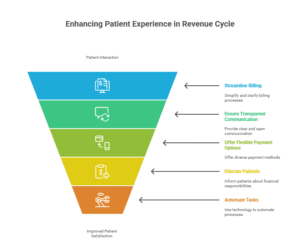On-Demand Outsourcing BPO Services for Healthcare Providers With 24/7 Coverage!
Save up to 70% on staffing costs!
Browse Specialty Staffing ServicesEnhancing Patient Experience Through Healthcare Revenue Cycle Management

In today’s patient-centered healthcare landscape, financial experience plays an increasingly critical role in overall satisfaction. The healthcare revenue cycle, once seen purely as a back-office function, now significantly influences how patients perceive their care journey. From appointment scheduling to final billing, each financial interaction contributes to the overall experience. Optimizing the revenue cycle with a patient-first approach is essential not only for revenue retention but also for fostering trust, transparency, and loyalty.
The Link Between Revenue Cycle and Patient Experience
While the clinical experience remains vital, studies show that patients also judge their overall satisfaction based on financial clarity, affordability, and the ease of navigating administrative tasks. Poor communication, confusing bills, and unexpected costs can lead to frustration and even delayed care. Revenue cycle touchpoints—including pre-registration, eligibility verification, payment collection, and patient communication—are now key components of a seamless care experience.
Common Friction Points in the Revenue Cycle
Unclear Pricing and Estimates: Patients often receive care without knowing the cost, leading to surprise bills.
Manual Registration and Paperwork: Long waits and redundant forms diminish the patient’s first impression.
Limited Payment Options: Rigid payment systems discourage timely payments and increase financial anxiety.
Confusing Billing Statements: Poorly designed statements cause misunderstandings and require multiple follow-ups.
Lack of Financial Education: Patients are often unaware of their benefits, out-of-pocket responsibilities, or payment assistance options.
Strategies to Improve Patient Experience in the Revenue Cycle

1. Enhance Price Transparency
Provide real-time cost estimates based on insurance eligibility and service type.
Offer online tools or portals where patients can check benefits and calculate out-of-pocket costs before procedures.
2. Streamline Front-End Processes
Enable digital pre-registration and intake forms to reduce wait times and manual errors.
Integrate real-time insurance verification to ensure coverage is confirmed before service.
3. Offer Flexible and Digital Payment Options
Support mobile payments, online portals, and contactless payment methods.
Introduce payment plans for high-cost procedures to ease financial burden.
Provide automated billing reminders via email or SMS.
4. Simplify Billing Communication
Design clean, easy-to-read billing statements with clear language and visual summaries.
Combine clinical and financial information into a single unified patient portal.
Offer multilingual support and patient advocates for clarification when needed.
5. Educate and Empower Patients
Include cost-related FAQs and insurance guides in both print and digital formats.
Host webinars or short video explainers about how billing and insurance work.
Train staff to communicate with empathy and clarity when discussing financial responsibilities.
Technology’s Role in Patient-Centered RCM
CRM & Patient Portals: Centralize communication, appointment history, and payment status.
Artificial Intelligence: Predict billing errors, recommend payment plans, and personalize financial communications.
Robotic Process Automation: Eliminate delays in insurance checks, claim status updates, and payment posting.
Benefits of a Patient-Focused Revenue Cycle
Higher Patient Satisfaction: Financial clarity improves trust and perception of care quality.
Faster Payments: Transparent billing and multiple payment channels lead to quicker revenue collection.
Reduced Call Volume: Clear communication decreases patient confusion and call center burden.
Stronger Brand Loyalty: Positive financial experiences increase retention and referrals.
What Did We Learn?
In a healthcare environment that increasingly values transparency, convenience, and digital access, improving the patient experience through revenue cycle management is no longer optional—it’s a strategic imperative. By aligning financial processes with patient needs, healthcare providers can not only increase revenue but also strengthen relationships, reduce churn, and deliver truly holistic care.
What People Are Asking?
1. How does the revenue cycle impact patient experience?
It affects how patients perceive billing clarity, affordability, and the ease of financial interactions throughout their care journey.
2. What frustrates patients most in the billing process?
Common issues include unclear costs, confusing bills, limited payment options, and lack of financial guidance.
3. How can providers improve financial transparency?
By offering real-time cost estimates, clear billing statements, and upfront discussions of financial responsibility.
4. What role does technology play in improving patient experience?
Tech tools like patient portals, AI, and automation streamline billing, provide estimates, and simplify payments.
5. Why is patient-centered RCM important for providers?
It increases satisfaction, speeds up payments, reduces administrative burden, and builds long-term patient trust.
Disclaimer
For informational purposes only; not applicable to specific situations.
For tailored support and professional services,
Please contact Staffingly, Inc. at (800) 489-5877
Email : support@staffingly.com.
About This Blog : This Blog is brought to you by Staffingly, Inc., a trusted name in healthcare outsourcing. The team of skilled healthcare specialists and content creators is dedicated to improving the quality and efficiency of healthcare services. The team passionate about sharing knowledge through insightful articles, blogs, and other educational resources.
 Book a Demo to Build Your Team Today!
Book a Demo to Build Your Team Today!

 Read Case Studies
Read Case Studies 


 Virtual Medical Assistants
Virtual Medical Assistants



